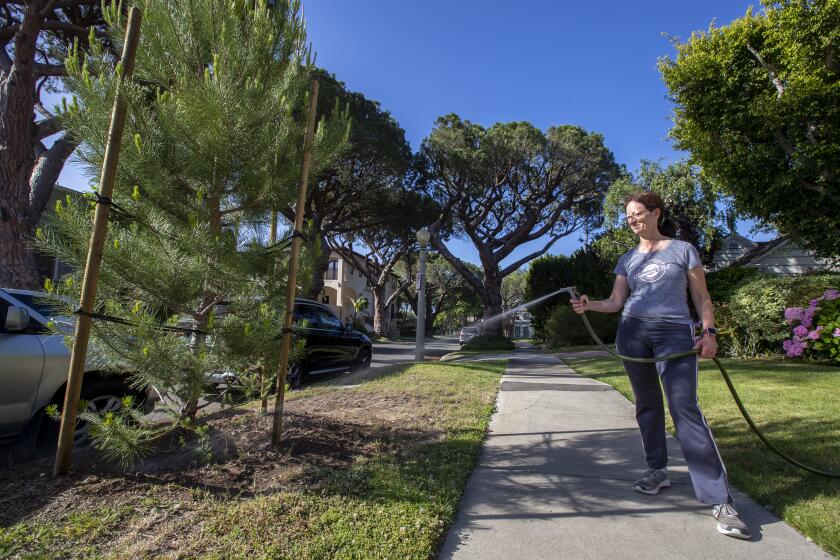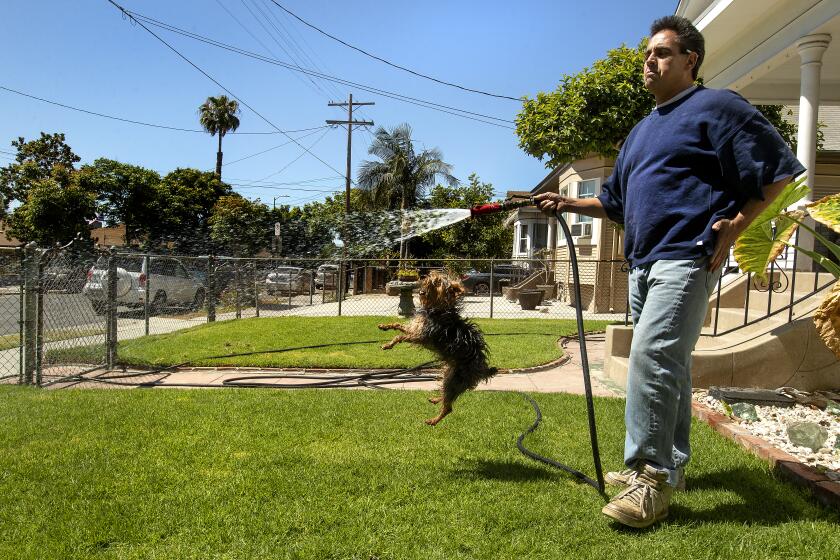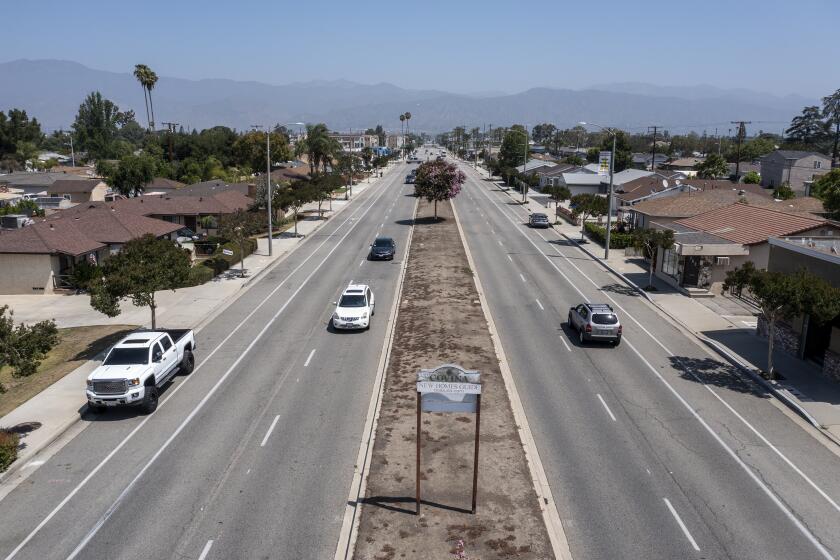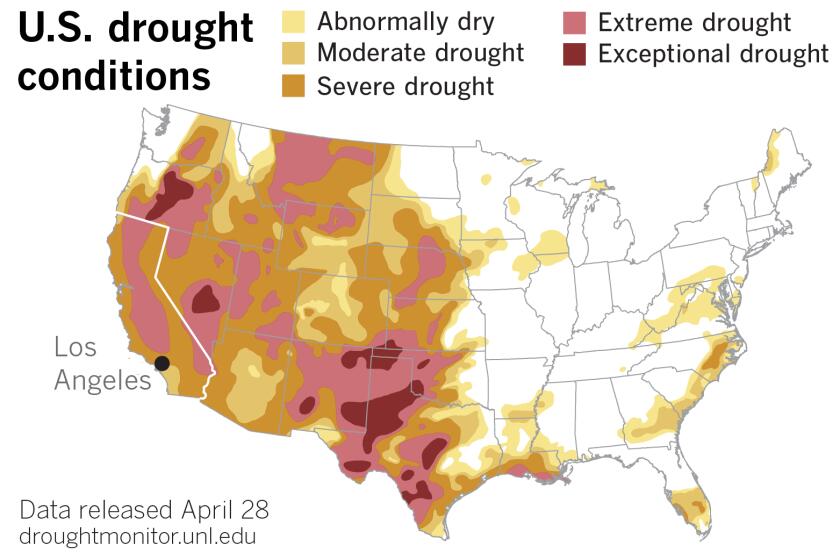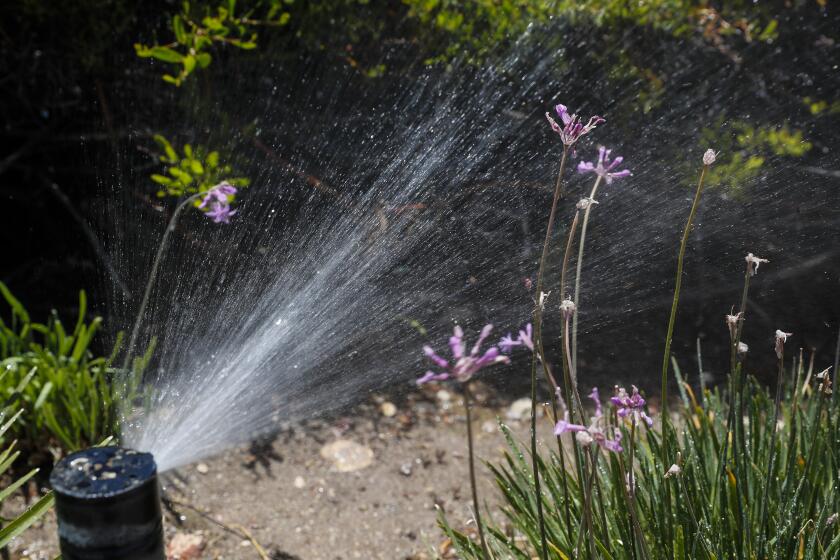Will water restrictions bring more destructive SoCal brush fires? Some demand more water
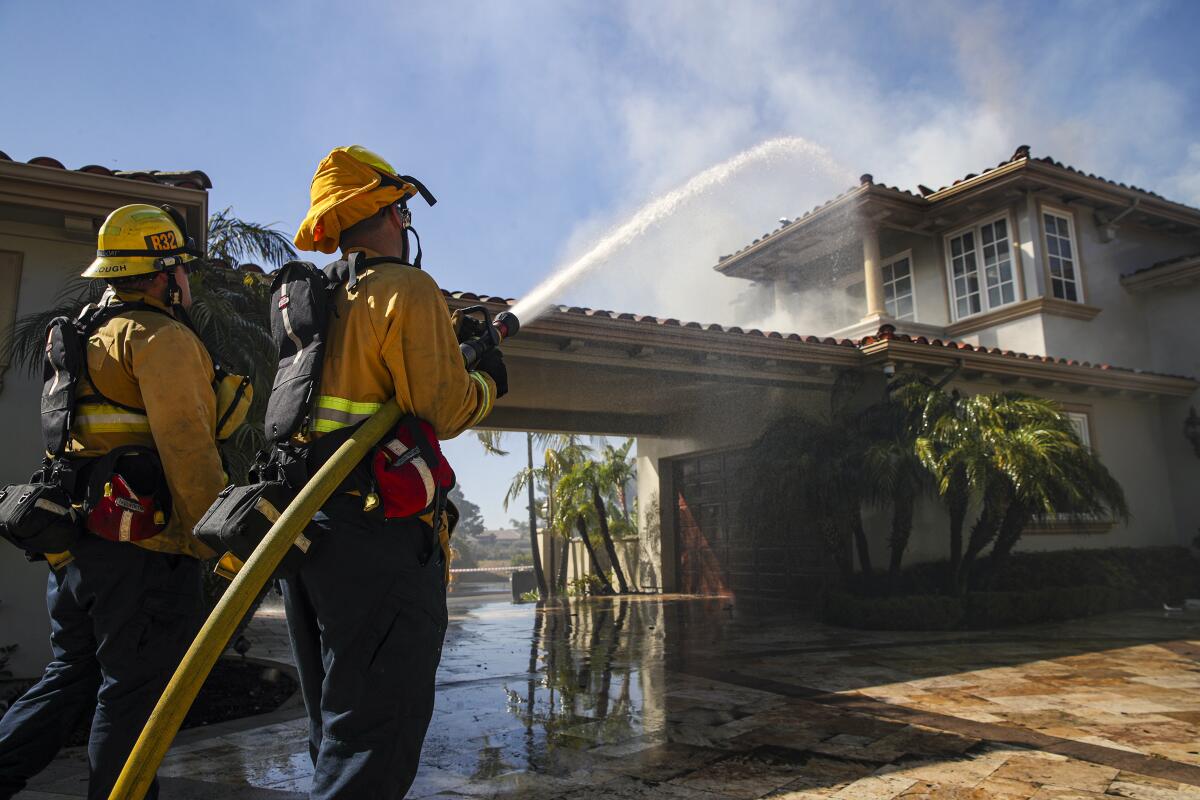
- Share via
After losing dozens of oak trees, a guest house and a garage filled with mementos of her late husband in the 2018 Woolsey fire, Nicole Radoumis dreads the arrival of extreme fire weather amid a punishing California drought.
Recently however, the Agoura Hills resident grew even more apprehensive after the Metropolitan Water District of Southern California imposed strict one-day a week outdoor watering restrictions for areas that rely on water from the depleted State Water Project. Radoumis now worries that her two-acre property will be filled with dead, tinder-dry vegetation that will serve as fuel for wildfires.
In a city that falls almost entirely within a very high fire hazard severity zone, Radoumis and her neighbors argue that the watering restrictions could place their homes — and lives — at increased peril.
“We have to take care of our properties differently,” the 56-year-old said. “You can’t have a one-size-fits-all blanket approach to the situation.”
Historic water restrictions took effect as residents braced for a long brown summer of drought.
Based on similar concerns voiced by residents in affected areas, municipal water districts in Los Angeles and Ventura counties are now asking state water officials to allocate more water under the health and safety exception for drought rules, using the rationale that it should include the mitigation of wildfire risk.
But even as water agencies and their customers argue for more water to maintain vegetation, some drought and wildfire experts question the wisdom of such a move. They say the best strategy for reducing wildfire risk is to build fire-hardened homes and to clear large areas of defensible space around structures.
“We have a lot of people living in these high hazard zones with homes that are not designed to be fire resistant,” said Daniel Swain, a UCLA climate scientist. “If you have dense brush and trees up against your house on a hot, windy day, it doesn’t matter if they’re well irrigated. They’re still going to burn.”
From Boyle Heights to Bel-Air, it’s going to be a summer of brown grass and hard choices.
Public fears over how drought restrictions would affect wildfire activity dominated a recent town hall meeting of the Las Virgenes Municipal Water District, which serves communities in and around the Santa Monica Mountains, including Agoura Hills, Hidden Hills, Westlake Village and Calabasas. Several speakers had survived the Woolsey fire, which destroyed more than 1,600 structures from Thousand Oaks to Malibu, and killed three.
“If you live in an urban area, let your garden die, it’s OK. But if you live in an area designated by the state as a very high fire hazard severity zone, that’s not an option anymore,” said John Zhao, director of facilities and operations for the Las Virgenes Municipal Water District. “That’s why it’s so important to recognize our unique need to keep the vegetation alive. … It’s part of the health and safety of living in this area.”
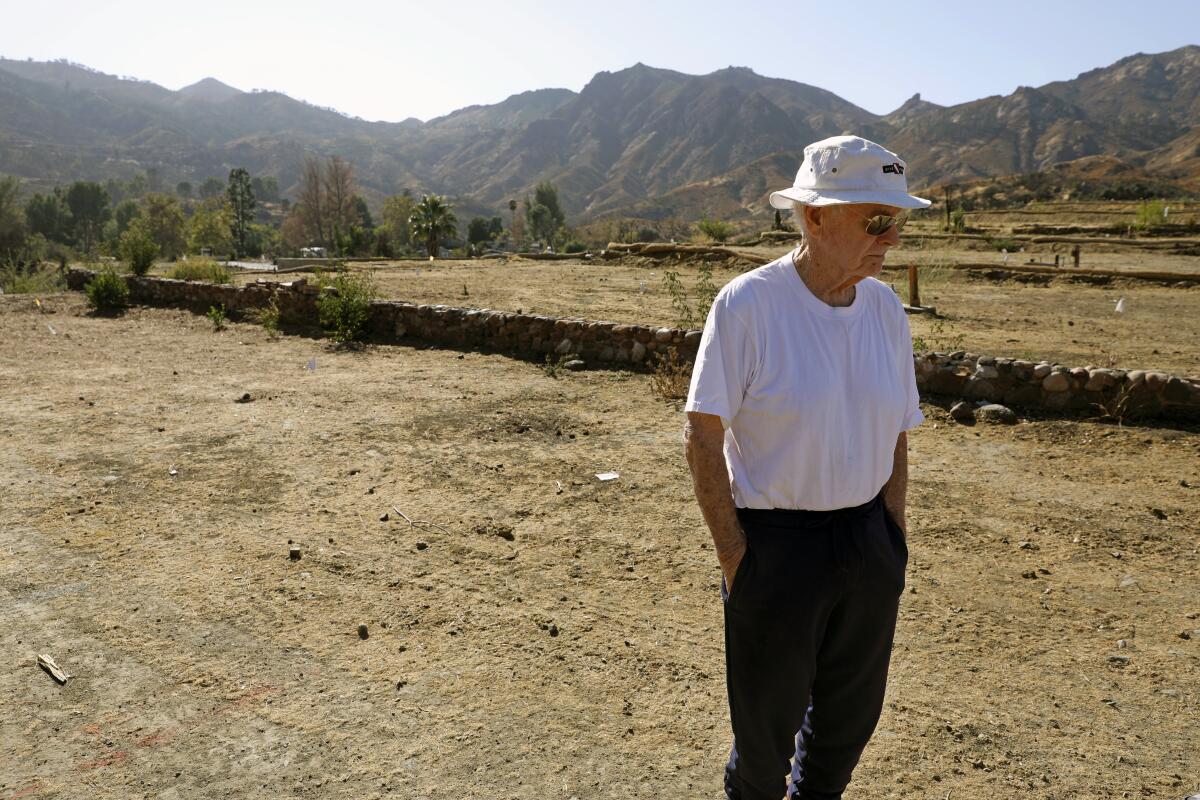
Last month, Sen. Henry Stern (D-Malibu) sent a letter to Karla Nemeth, director of the California Department of Water Resources, citing the Woolsey fire — although no watering restrictions were in effect during that fire. Stern said he was “very concerned that sufficient water supplies may not be available to maintain fire-resistant landscaping for wildfire safety and protection at the urban-wildland interface,” and added that he hoped for favorable consideration of the water districts’ request.
In the wake of its historic drought order, the Metropolitan Water District has asked its six affected member agencies — Las Virgenes, the Los Angeles Department of Water and Power, Calleguas Municipal Water District, Three Valleys Municipal Water District, Upper San Gabriel Municipal Water District and the Inland Empire Utilities Agency — to evaluate whether they need more water and how much.
“Metropolitan is working with local water agencies to understand the need for additional water supplies for wildfire safety and to communicate this need to the state Department of Water Resources,” read an MWD statement on the matter. “Agencies are in the process of determining the amount of additional water needed to maintain landscaping critical to fire suppression in the wildland-urban interface.”
MWD will submit the request for additional water to the state, which has indicated that it’s open to the inquiry, the statement said.
More than 6 million Southern Californians will be placed under new drought rules today in an unprecedented effort to conserve water.
Nemeth, of the California Department of Water Resources, said her agency “is working closely with Metropolitan and other agencies to determine their specific ongoing water supply needs.” Public safety is of paramount concern to the department, she said.
Exactly what constitutes a health and safety use of water is defined in agreements between the California Department of Water Resources and the agencies it supplies, Nemeth said. “In this context, a health and safety need means the water supply for domestic, sanitation and fire-suppression use,” she said.
David Pedersen, general manager of the Las Virgenes water district, said wildfire protection should have been factored into each district’s health and safety needs, but wasn’t.
“We are actually working hard to change that,” Pedersen said.
Las Virgenes, DWP, Calleguas and Three Valleys Municipal are requesting more water.
Among other concerns, the districts want to ensure that they have adequate water during red-flag warning days for firefighters to water down vegetation surrounding homes and some open spaces.
But some experts worry that increasing outdoor watering this year is not sustainable and could result in larger problems. They say it is time to enact long-term solutions.
“We have a dry climate and it’s likely to become a bit drier over time,” said water expert Jay Lund, a professor of civil and environmental engineering at UC Davis. “So asking for more water to get out of fire problems is not a long-term strategy.”
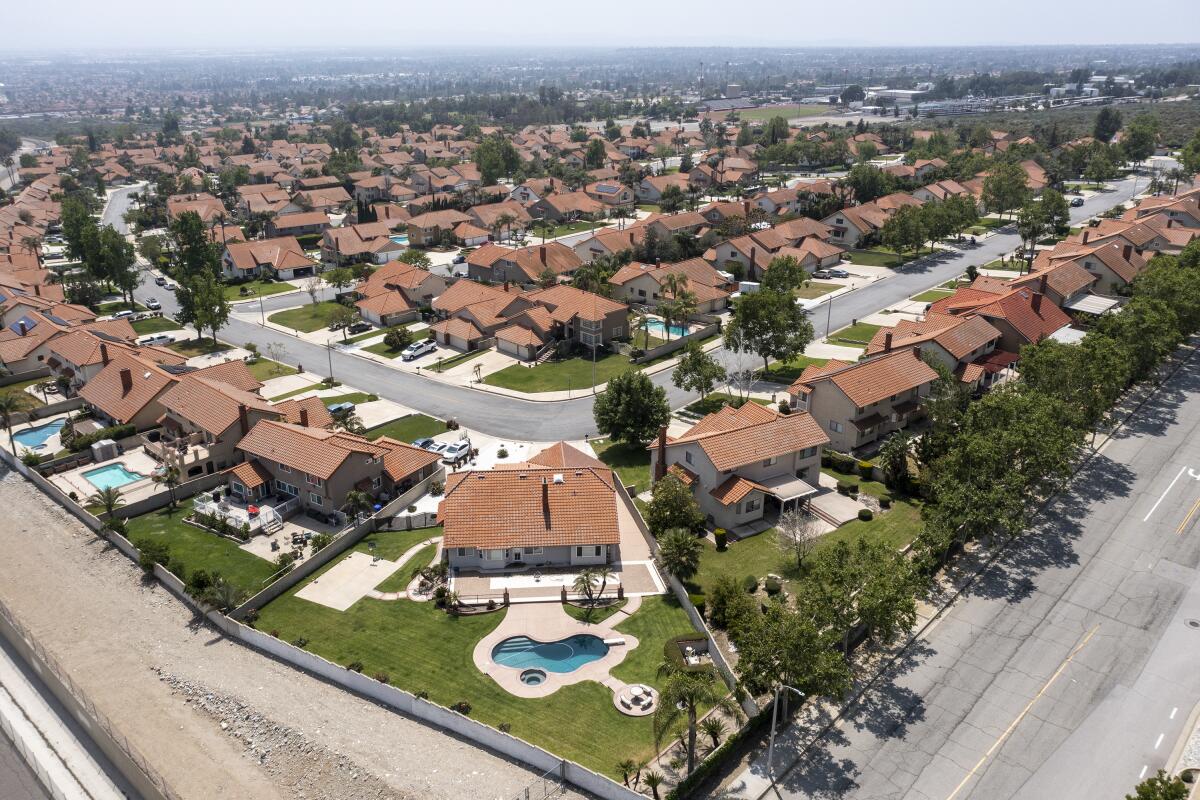
Swain, of UCLA, questioned the effectiveness of preemptively wetting areas of the wildland-urban interface, because climate change has heightened fire risk by increasing the propensity of the atmosphere to suck water out of the landscape. Under such conditions, a farmer can deeply irrigate a field in the morning and the soil will be cracked and dry by the afternoon, he said.
Swain said moats of green around people’s homes don’t often make a difference in determining the outcome of wildfires under the types of severe weather conditions that are increasingly driving these events. He noted that the Coastal fire destroyed numerous homes in Laguna Niguel recently, despite the presence of verdant bushes and green lawns.
“You can even imagine a case from an urban fire risk context in which you push it in one direction by irrigating more now and then you have less available later to actually deal with the fires that do occur,” he said. “So it’s tricky. I don’t think there are easy answers.”
Still, concerns about water restrictions and wildfire persist.
La Niña was expected to dissipate, but it may linger through the summer. That’s bad news for drought and wildfire-prone California.
During the Las Virgenes town hall on May 11, there were dozens of questions and remarks. One woman said that she and her husband’s garden was “one of the only things protecting our home.”
“If it turns brown we will be at HIGH risk,” she wrote. “We are planning on staying the next fire to protect our home, but we are 83 and we need our garden green for protection.”
Another claimed that if her hill was not watered, it would not be in compliance with her fire insurance.
In an interview with The Times, Radoumis said her experience with the Woolsey fire had left her shaken.
“It was extremely traumatizing going through that and just feeling so helpless,” she said.
She still has oak trees on the property and fruit trees around the perimeter of her property — part of her defensible space, she said. Those trees are a couple years old and are “still settling and they need water.” Almost all of her trees are drip irrigated, as is her vegetable garden.
But she also uses a regular sprinkler system to water the lawn and said that, “if I’m not watering enough to keep the lawn alive, then all the other plants around will die as well.”
Pedersen stressed that the purpose of the request is not for residents to use fire protection as a means to get more water for their lawns.
“I will ensure that doesn’t happen,” he said.
Here are 10 things to consider as the new restrictions — most notably limiting outdoor watering to one or two days a week — set in.
While defensible space recommendations typically call for a lean, clean and green landscape — which generally requires some amount of irrigation, depending on the type of vegetation — it’s just as important for homeowners to make wise choices of what to plant and where, said Susie Kocher, forestry and natural resources advisor with UC Cooperative Extension in the Central Sierra Nevada.
“I don’t care if you do irrigate, I always recommend you don’t put vegetation within five feet of your house or under windows, where if a shrub catches on fire, the heat can break a window,” she said.
It makes sense to use limited water supplies on trees, as they are long-lived and benefit from occasional watering, she said. If smaller vegetation can’t be watered enough to keep it from dying and posing a fire hazard, another option is to remove it altogether, she said.
“In general, most people don’t want just bare dirt, but clearly that’s a fire-resistant landscape,” she said.
Zhao acknowledged that the district can continue educating residents not to grow too much vegetation and to potentially rethink the landscape, but called that “a long-term goal.”
“Right now we’re thinking about how to weather the next fire season,” he said.
More to Read
Sign up for Essential California
The most important California stories and recommendations in your inbox every morning.
You may occasionally receive promotional content from the Los Angeles Times.
